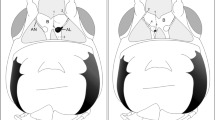Summary
In the abdominal ganglia of the turnip moth Agrotis segetum, an antibody against the cockroach neuropeptide leucokinin I recognizes neurons with varicose fibers and terminals innervating the perisympathetic neurohemal organs. In the larva, the abdominal perisympathetic organs consist of a segmental series of discrete neurohemal swellings on the dorsal unpaired nerve and the transverse nerves originating at its bifurcation. These neurohemal structures are innervated by varicose terminals of leucokinin I-immunoreactive (LKIR) fibers originating from neuronal cell bodies located in the preceding segment. In the adult, the abdominal segmental neurohemal units are more or less fused into a plexus that extends over almost the whole abdominal nerve cord. The adult plexus consists of peripheral nerve branches and superficial nerve fibers beneath the basal lamina of the neural sheath of the nerve cord. During metamorphosis, the LKIR fibers closely follow the restructuration of the perisympathetic organs. In both larvae and adults the LKIR fibers in the neurohemal structures originate from the same cell bodies, which are distributed as ventrolateral bilateral pairs in all abdominal ganglia. The transformation of the series of separated and relatively simple larval neurohemal organs into the larger, continuous and more complex adult neurohemal areas occurs during the first of the two weeks of pupal life. The efferent abdominal LKIR neurons of the moth Agrotis segetum thus belong to the class of larval neurons which persist into adult life with substantial peripheral reorganization occurring during metamorphosis.
Similar content being viewed by others
References
Ali FA (1973) Post-embryonic changes in the central nervous system and perilemma of Pieris brassicae (L.) (Lepidoptera: Pieridae). Trans R Entomol Soc Lond 124:463–498
Ashurst DE, Richards AG (1964) A study of the changes occurring in the connective tissue associated with the central nervous system during the pupal stage of the wax moth, Galleria mellonella L. J Morphol 114:225–236
Cantera R, Nässel DR (1992) Segmental peptidergic innervation of abdominal targets in larval and adult dipteran insects revealed with an antiserum against leucokinin I. Cell Tissue Res (in press)
Carr JN, Taghert PH (1988a) Formation of the transverse nerve in moth embryos. I. A scaffold of nonneuronal cells prefigures the nerve. Dev Biol 130:487–499
Carr JN, Taghert PH (1988b) Formation of the transverse nerve in moth embryos. II. Stereotyped growth by the axons of identified neuroendocrine neurons. Dev Biol 130:500–512
Cook BJ, Holman GM, Wagner RM, Nachman RJ (1989) Pharmacological actions of a new class of neuropeptides, the leucokinins I–IV, on the visceral muscles of Leucophaea maderae. Comp Biochem Physiol 93:257–262
Griffiths AC, Finlayson LH (1982) Extra-ganglionic neurosecretory and non-neurosecretory neurons in the larva of the moth, Agrotis segetum Schiff (Lepitoptera: Noctuidae). Int J Insect Morphol Embryol 11:341–349
Hinks CF (1975) Peripheral neurosecretory cells in some Lepidoptera. Canad J Zool 53:1035–1038
Holman GM, Cook BJ, Wagner RM (1984) Isolation and partial characterization of five myotropic peptides present in head extracts of the cockroach, Leucophaea maderae. Comp Biochem Physiol 77C:1–5
Lundquist T, Nässel DR (1990) Substance P-, FMRFamide-, and gastrin/cholecystokinin-like immunoreactive neurons in the thoracico-abdominal ganglia of the flies Drosophila and Calliphora. J Comp Neurol 294:161–178
Nässel DR, Elekes K (1985) Serotonergic terminals in the neural sheath of the blowfly nervous system: ultrastructural immunocytochemistry and 5,7-dihydrosytryptamine labeling. Neuroscience 15:293–307
Nässel DR, Lundquist T (1991) Insect tachykinin-like peptide: distribution of leucokinin immunoreactive neurons in the cockroach and blowfly brains. Neurosci Lett 130:225–228
Nässel DR, Ohlsson LG, Cantera R (1988) Metamorphosis of identified neurons innervating thoracic neurohemal organs in the blowfly: transformation of cholecystokininlike immunoreactive neurons. J Comp Neurol 267:343–356
Nässel DR, Cantera R, Karlsson A (1992) Neurons in the cock-roach nervous system reacting with antisera to the neuropeptide leucokinin I. J Comp Neurol (in press)
Provansal A (1972) Les organes périsympathiques des Lépidopteres. CR Acad Sci Paris 274D:97–100
Raabe M (1989) Recent developments in insect neurohormones. Plenum Press, New York
Raabe M, Baudry N, Grillot J-P, Provansal A (1971) Les organes périsympathiques des insectes Pterigotes. Distribution. Caractères généraux. CR Acad Sci Paris 273D:2324–2327
Taghert PH, Carr JN, Wall JB, Copenhaver PF (1986) Embryonic formation of a simple neurosecretory nerve in the moth, Manduca sexta. In: Borkovec AB, Gelman DB (eds) Insect neurochemistry and neurophysiology. The Human Press, New Jersey
Author information
Authors and Affiliations
Rights and permissions
About this article
Cite this article
Cantera, R., Hansson, B.S., Hallberg, E. et al. Postembryonic development of leucokinin I-immunoreactive neurons innervating a neurohemal organ in the turnip moth Agrotis segetum . Cell Tissue Res 269, 65–77 (1992). https://doi.org/10.1007/BF00384727
Received:
Accepted:
Issue Date:
DOI: https://doi.org/10.1007/BF00384727




